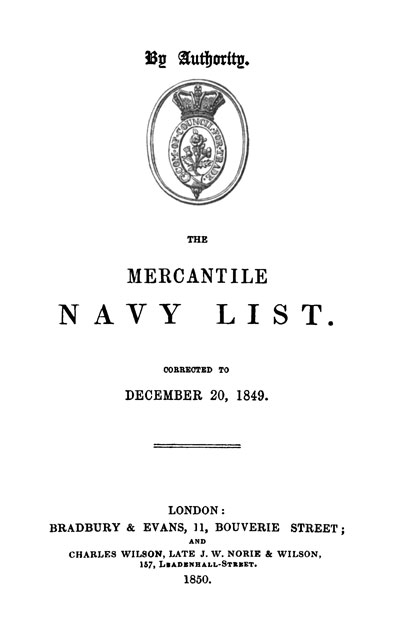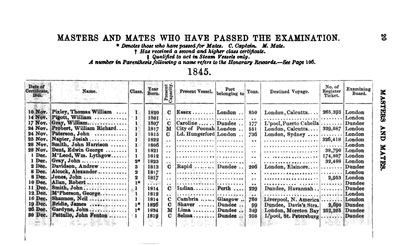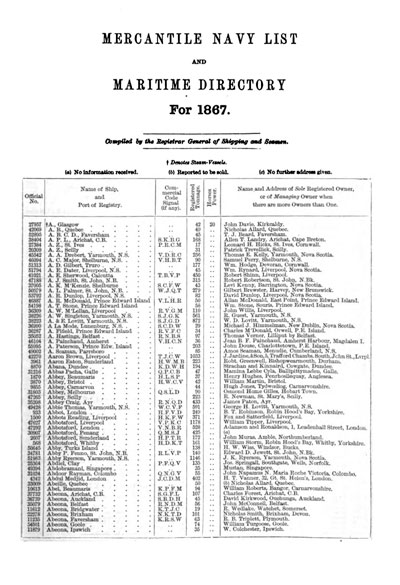 In 1845, in order to bring Great Britan into line with the rest of Europe which required all Masters and Mates to have passed an examination and obtain a certificate of competancy, The Lords of the Committee of the Privy Council for Trade brought in regulations for a voluntary examination.
In 1845, in order to bring Great Britan into line with the rest of Europe which required all Masters and Mates to have passed an examination and obtain a certificate of competancy, The Lords of the Committee of the Privy Council for Trade brought in regulations for a voluntary examination.
The Lords of the Admiralty expanded on this and from 23rd of March, 1847, no vessel was able to be taken up as a transport, convict, or freight ship, unless the Master and Mates had obtained the required certificates.
This was further extended to passenger freight ships and others over which the Government, the Honourable East India Company, the Royal West Indian Mail, and the British and North American Mail Companies exercised control.
A Bill was then introduced into Parliament making the condition compulsory for masters and mates who obtained their ratings for the first time after the 1st January, 1851. Masters and mates who had already served in such a capacity also had to possess an authenticated attested certificate of the fact before their vessel could effect a clearance at the Custom House so they would not be required to undergo examination.
The Mercantile Navy List was established, under the superintendence of the Registrar General of Seamen, to publicise the names of those who possessed certificates and was published half-yearly from 1849. After 1857 it was issued annually until 1976 (with supplements up to the end of 1977), with the exception of 1941 to 1946 during the Second World War. Monthly supplements were issued under various titles from 1886.

Initially being a source of information on masters and mates who had obtained a certificate of competency, the early volumes also included lists of pilots, receivers of wreck, obituaries, and records of awards and testimonials for services at sea, ships signals and various official notices and statistics.
Of particular interest to the family historian the 1849 and 1850 publications gave the year of birth of those examined.
The initial publications also gave a list of registerd Steam Vessels. With the passing of the Merchant Shipping Act of 1854 every British registered ship was to be given an official number to be recorded on the certificate of registry and marked upon her main beam. This register would include name of vessel, port of registry, tonnage, signal letters and name and address of the owner(s). These details where then added to the Mercantile Navy List.
In the mid-1860s the names of Masters and Mates were dropped from the List.
Only a few near-complete sets exist with even the British Library set missing two volumes. The National Maritime Museum has editions which cover the period from 1857 to 1976.
 The Mercantile Navy List provides a comprehensive index to ships' official numbers from 1854 to 1976 and provides basic information on each ship, which can be used to trace other records and to compile an outline history of a ship and its owners.
The Mercantile Navy List provides a comprehensive index to ships' official numbers from 1854 to 1976 and provides basic information on each ship, which can be used to trace other records and to compile an outline history of a ship and its owners.
The same numbering system is used for crew lists and certificates held at The National Archives and in other repositories, making the Mercantile Navy List a primary resource for searching maritime records.
Many of the available editions are being digitised and a list of those available can be found at maritimearchives.co.uk
An explanation of how to use the List can be found at PortCities Southampton: How to use the Mercantile Navy List
=====================================================From the Mercantile Navy List - 1849
INTRODUCTION.
The laws of all European nations (except Great Britain) require that Masters and Mates shall undergo an examination, and possess certificates of qualification, before they are eligible to be intrusted with the charge of Merchant Vessels; a reasonable condition, in which Shipowners and Underwriters are greatly interested.
The Lords of the Committee of the Privy Council for Trade have been pleased to promulgate regulations, dated 19th August, 1845, under which a voluntary examination may be passed, and certificates of qualification obtained ; and in furtherance of this design, the Lords of the Admiralty have announced that, from and after the 23rd of March, 1847, no Vessel shall be taken up as Transport, Convict, or Freight Ship, unless the Master and Mates have obtained the required certificates.
The regulation has been extended to Passenger Freight Ships, and to others over which The Government, The Honourable East India Company, The Royal West Indian Mail, and the British and North American Mail Companies exercise control; and a Bill has been introduced into Parliament by the Right Hon. The President of the Board of Trade, making the condition compulsory on Masters and Mates who assume their ratings for the first time after the 1st January, 1851.
Masters and Mates who have already served in such capacities must also possess authenticated attested certificates of the fact before their vessels can effect a clearance at the Custom House, it not being intended that such persons shall be required to undergo examination.
These regulations are called for not only by the very general expression of public opinion, that those in charge of life and property should possess the qualification necessary for so important a trust; but in order the better to enable Masters of British vessels to compete with foreigners for freights in the markets of the world, by the production of satisfactory credentials as to their competency.
In order to give publicity to the names of those who possess certificates, whether of examination -- or of previous service -- "The Mercantile Navy List" is established under the superintendence of the Registrar General of Seamen, by authority of the Lords of the Committee of Privy Council for Trade; and it will be published Half-yearly, corrected up to the latest period.
The title, under its present appearance, may seem a misnomer; but it being intended to extend the design, so as to embrace all information useful, if not essential io Shipmasters, in an authentic form, a comprehensive title has been adopted in the first instance.
To the names of Master Mariners and Mates are appended such honorary rewards or testimonials as they may have obtained for services performed ; and it is requested that parties so distinguished will transmit an authenticated account of the same, and that certificated Master Mariners and Mates will notify any change of Ship as often as it occurs.
All communications to be addressed (post-paid) to the care of the publishers, Messrs. BRADBURY & EVANS, 11, Bouverie-street ; or CHARLES WILSON, late J. W. NORIE & WILSON, 157, Leadenhall-street, London.
J. H. BROWN,
Registrar-General of Seamen.
General Register and Record Office of Seamen, Custom House, London, 1st January, 1850.
MEMORANDUM.
Mates, when they become Masters, should be careful to set forth the number of their Register Tickets, when making the returns required under the provisions of the Merchant Seamen's Act. This will greatly facilitate the means of substantiating claims on the Fund hereafter, either on the part of themselves or widows, when certificates are lost. One of the principal objects of the Register Ticket is to give to those who have claims the ready means of proving them, by reference to the Record of their Voyages; and its value will be more appreciated when the Fund is placed on a satisfactory footing, and a substantial provision established for worn-out Mariners and their relicts. Although Master Mariners are not required by law to possess Register Tickets, they can obtain them at any Custom House, and they will find their interest promoted by insuring that a Record of their service shall be maintained, whether as Masters or Mates.

